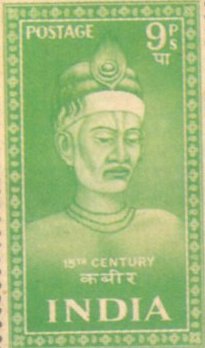Saint Kabir
by Jyotsna Kamat
First Online: November 02, 2001
Page Last Updated: December 07, 2024
Introduction | Important
Proponents | Pictures
Alvars | Shankara |Bridal Devotion | The
Alvars | Ramanuja | Madhva | Ravidas
Meerabai | Guru Nanak | Chaitanya | Purandaradas
Ramananda | Kabir | Tukaram | Kanakadas
Saint Kabir (15th century: 1440-1518 A.D.)
Kabir is the most known disciple of Ramananda. Tradition says that he was a adopted son of a poor Muslim weaver couple who were earlier Hindus. They belonged to a lower strata in the eyes of both Hindus and Muslims, and hence not bound by strict rituals and religious discipline. This made Kabir an unconventional poet and mystic. He had no regular schooling and took to weaving, his family vocation and went on singing poems as he plied the shuttle to and fro.

Saint Kabir
He could not serve or claim anybody as guru because of his humble birth but was drawn to Ramanand's teachings. He thought of winning Guru's blessings in its own way. Ramananda went to the river Ganga, everyday for bath very early in the morning. One day when he was returning from Ghat, his foot touched a human body in the darkness. Startled he exclaimed, "Ram, Ram!" Immediately Kavir got up and with folded hands and appealed to the saint. "Master, you have given me the Ram mantra and made me your Sishya, even though I am only a poor Muslim weaver" and told about his yearnings to reach God. Ramananda was touched deeply by Kabir's devotion and humility and accepted him as a disciple. he became a worthy sishya in no time by imbibing many secrets of spiritual mysticism from Ramananda.
He started preaching in the most unconventional way. He continued with his vocation of weaving and composed songs as he worked. Though leading a God-intoxicated life, he stressed on manual labor, equality of man and condemned religious bigotry. He stressed on simple life and meditation. People liked the moral message in his songs which poured out from his heart and , who was the very embodiment of things he uttered. He condemned image-worship in temples and mechanical prayers in mosques. he had a large following of Hindus and Muslims. But the orthodoxy of both the religions (Purohits and Mullas) hated him and he was persecuted by both. Ultimately he was forced to leave Banaras and it seems he spent his last days wandering. He was married and had a son and daughter but his family life was not a happy one. According to the legend he died a very old man. On his death, Hindus and Muslims quarreled to claim his body. But when they lifted the shroud, there was only a big heap of roses. It is told that Hindus and Muslims shared equally the flowers and had the last rites per formed of their beloved guru according to their own custom. One community built a temple and another dargah. So goes the story.
God to Kabir was all pervading supreme spirit. Ram and Rahim personified the same supreme spirit who could be won over only by pure devotion. Rituals or blind worship had no place in his way of serving God. "Seek him in the depth of your heart!" Kabir advised.
"If God dwells only in the mosque, to whom belongs the rest of the country? Those who are called Hindus say that God dwells in an idol; I see not truth in either sect. Oh God, whether Allah or Ram I live by thy name... Hari dwells in the south. Allah in west. Search in thy heart, search in the heart of hearts, there is His abode," he exclaimed.
Kabir turned out a saint of the masses. His simple and god-intoxicated life became an ideal. His simple compositions --"dohe"--two liners or "chowtai"--four liners were easy to remember and became popular immensely and enabled to grasp essentials of simple spiritual life. A common guru for Hindus and Muslims was the dire requirement of the age, and arrival of Kabir on the National Scene provided the spiritual bond. His songs profoundly influenced the religious belief of the simple rural folk. As is common in India. Each saint acquires the status of a founder of sect. Innumerable followers in North India came to be known as kabirpanthis and followers of his guru came to be known as Ramanandis.
Through his peculiar use of Hindustani language he achieved linguistic unity. Originally he sang in Bhojpuri a dialect of Hindi in East India. He stayed for long in Banaras and we can detect Awadhi and "Brij" influence. But collected songs of Kabir like (a) Sakhi (songs--dohe), (b) Sabad (sayings, utterances), (c) Ramaini , mainly spiritual guidelines; all have Punjabi influence. His songs find place in Granth Sahib--sacred text of Sikhs. Rabindranath Tagore has translated one hundred of his songs into English. Kabir's compositions originally existed in hundreds and his disciples of different regions, collected them and popularized throughout the country through wandering ascetics (Gosais).
The followers of Kabir can still be found in present day India (year 2004). They call themselves "Kabir Panthis".
![]()
Introduction | Important
Proponents | Pictures
Alvars | Shankara |Bridal Devotion | The
Alvars | Ramanuja | Madhva | Ravidas
Meerabai | Guru Nanak | Chaitanya | Purandaradas
Ramananda | Kabir | Tukaram | Kanakadas
See Also:
-
The Holy Men of India -- Archaryas, Sages, Sadhus, and Swamis

